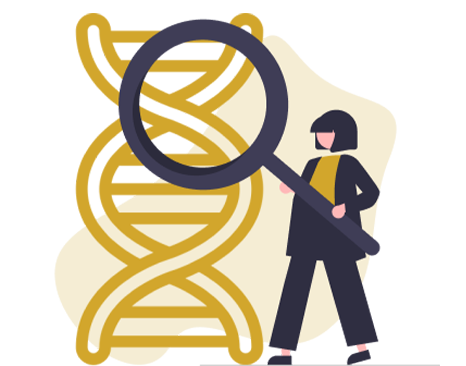
WHAT WE DO
We help you lose weight, manage diabetes, and achieve your best health through our gold standard DNA-based personalised wellness programs.

We help you lose weight, manage diabetes, and achieve your best health through our gold standard DNA-based personalised wellness programs.
It is the most scientific way to the athletic development of a child. No wonder it is used by leading national and international sports people.

Identifies the body’s response to food and physical exercise.

Discovers risk profile for injury and recovery.

Identifies the genetic strength for optimizing sports performance.

Deeply personalises nutrition based on genetic profile.

Discovers the muscle fibre type for personalised physical activity.

Significantly improves the effectiveness of sports coaching.

We use gold standard DNA testing to deliver DNA report with more than 99% accuracy.

We promote and recommend food-first approach.

We provide most scientifically personalised nutrition plan for your child’s growth.

A simple saliva based test for DNA testing.

The highly intuitive unlock.fit mobile app is your true wellness partner that makes it extremely easy for you to follow your wellness recommendations.
Your child’s DNA defines their nutrition plan. Our genomics experts and nutritionists work hard to personalise their nutrition plan to theirr DNA profile. The child gets this DNA-based nutrition plan on our app
Our certified Strength and Conditioning Coaches and genomics experts align each of the daily exercises for your child to their DNA that yield faster and better overall growth for the child.
We understand the value of human touch. Through the app, schedule 1-on-1 consultation for your child with one of our experts to address any queries and concerns. All our experts are certified in their domain and come with relevant experience.

DNA test with Saliva
Blood Parameters
Nutrition Assessment
Unique algorithm processes millions of DNA data and blood parameters to design a personalised wellness
Personalised
Nutrition
Personalised
Training


Parental access to progress and intervention

DNA – based nutrition & training on the app

Deep personalisation maximizes impact
Do not believe us. Believe what people have to say about us.
We believe in providing the best for you.
Looking for plans for your child?
Choose one of the following plans for your child's growth.

Our gold standard DNA testing is used by the world’s leading athletes to deeply personalise fitness for athletic performance enhancement. A comprehensive DNA test report unlocks the athletic growth possibilities for kids and athletes alike

Hugely trusted program by national and international athletes to improve their athletic development and performance. Based on our gold standard DNAPro Test, Blood parameters, and Nutrition Assessment, the kids get the most scientific and proven approach to optimum growth.
This product includes the following:
* Periodicity of the plan can be chosen at the time of Checkout
Please reach out to us in any of the following ways. We will be happy to help you.
DNA Test is a simple saliva test, that provides DNA analysis and reports on your individual genetic response to different fitness and nutrition markers. Using the information from this report, you can make better‐informed choices about how to exercise and eat, on the most personal level possible–by taking your genetic profile into account.
Optimising your diet and nutrition is always good in fighting all infectious and chronic diseases like diabetes, cancer, and cardiac. DNA based personalisation is most reliable way to achieve your optimum health. If you are eating healthy based on your DNA report chances are that you would catch less infection, and even if you get infected, the recovery will be much faster.
We are doing Nutrigenetic Testing. It’s the most comprehensive DNA test available in India for nutrition and fitness.
DNA tests can be used to understand predisposition of diseases. However we are not checking diseases markers in our test.
One size does not fit all – we all are different and therefore, we need personalised wellness, not a generic one based on our genetic profile. unlock. Fit’s DNA Test is just a simple saliva test but from this you will be provided with information to improve your health and fitness for a lifetime.
No blood is needed. Only saliva sample is collected in a very convenient and easy to use DNA Sample Kit. Full written step-by-step instructions are in the kit.
Your DNA sample is securely destroyed as per our lab quality manual and process.
We are using Illumine platform (Gold standard in DNA testing) for our DNA testing. Sensitivity and specificity of our tests is 99.9 %.
A healthy eating pattern provides enough of each essential nutrient from nutrient-dense foods, contains a variety of foods from all of the basic food groups, and focuses on balancing calories consumed with calories expended to help you achieve and sustain a healthy weight. This eating pattern limits the intake of solid fats, sugar, salt (sodium), and alcohol. The Dietary Guidelines by the Indian council of medical research-NIN for consumers guide creating a healthy eating pattern to reduce the risk of chronic diseases such as diabetes, cancer, and osteoporosis.
Milk products and fruits, whole grain bread and cereals, table sugar, starchy vegetables, and legumes. Carbohydrates are called “simple” or “complex,” depending on how fast your body digests and absorbs the sugar. You get simple carbohydrates from fruits, milk products, and table sugar. Complex carbohydrates include whole grain bread and cereals, starchy vegetables, and legumes. Complex carbohydrates and some simple carbohydrates provide vitamins, minerals, and fiber. Products made with refined sugar provide little nutrition. It is wise to limit these products.
There is no evidence to show that drinking 10-12 glasses of water is necessary. Generally, nutritionists recommend we follow the “8×8” rule, which is to drink eight 8-ounce glasses of water per day. Drinking more water does indeed boost metabolism – especially if your glass is icy cold. Your body must work to warm the water up, burning a few extra calories in the process. As for other benefits of water, 85% of your brain tissue is water, which means that if you’re dehydrated, both your body and your mind will be stressed.
BMI values between 18.5 and 24.9 are considered to be a “normal” or “healthy” weight. BMI values between 25 and 29.9 are considered “overweight,” while BMI values of 30 and above are considered “obese.” BMIs above 25 are unhealthy and have been shown to increase the risk of certain chronic diseases. BMIs under 18.5 is considered “underweight.”
Some fats are good for me. Monounsaturated fats: Substituted for saturated fats in your diet, they help lower bad LDL cholesterol and don’t reduce good HDL cholesterol. Found in canola oil, olive oil, olives, avocados, nuts, and nut butter. Polyunsaturated fats: Help lower cholesterol. Found in fatty fish, vegetable oils, nuts, and sunflower seeds.
Fish is a healthy choice when dining out. Ordering seafood such as salmon and tuna adds omega-3 fatty acids to your diet. They are a type of polyunsaturated fat that helps lower your heart disease risk. You’ll also find a different type of omega-3 in walnuts and edamame (soybeans).
Some people believe that having smaller, more frequent meals may help them lose weight. However, some studies suggest that meal size and frequency do not affect fat burning or body weight. Eating every 2–3 hours is inconvenient and completely unnecessary for the majority of people. Simply eat when you’re hungry and be sure to choose healthy and nutritious foods.
It’s entirely false that meat rots in your colon. Your body is well equipped to digest and absorb all the important nutrients found in meat. The protein gets broken down in your stomach by stomach acids. Then, powerful digestive enzymes break down the rest in your small intestine.
As per WHO we have to do 150 minutes of exercise in a week. So 30 minutes exercise for 5 days a week is a good start.
All our exercises are body weight exercises. Unless your assigned trainer believes that you need equipment based on counselling sessions with him/her, you would continue to exercise without any equipment. Also, one does not need to visit gym for the exercises – they can be easily completed at home.
Frequency, duration, intensity, and what kinds of exercises you do should be determined by what you are trying to accomplish. Your goals, your present fitness level, age, health, skills, interests, and convenience are among the factors you should consider. Still, you can reach your fitness goals in as little as three workouts per week!
The best thing about regular physical activity is that everyone can benefit from it. You are never too old to enjoy the benefits of regular physical activity! Being physically active can prevent and help treat many of the most common chronic medical conditions associated with aging. Physical activity is one of the most important steps older adults can take to maintain physical and mental health and quality of life.
Muscles develop from training and exercise. Extra servings of protein in foods or protein supplements do not assist in muscle development. A certain amount of protein is needed to help build the muscles, but a nutritious, balanced diet that includes 6-7 ounces from the meat/bean/egg group and 2-3 servings of dairy every day will supply all of the protein that the muscles need.
Forget doing hundreds of crunches and sit-ups to lose belly fat. The truth is that on their own, they are not likely to help the body lose that stubborn gut. Here is what works: a full-body exercise routine that builds lean muscle all over. The best plan for this is regular exercise, resistance training, and a healthy, calorie-controlled diet.
It is important to note that your genes cannot tell us your goals or what your goal should be. Rather by understanding your genetic profile in the context of your goal, you will be able to use the information to better tailor your training and nutrition to reach your goal, whatever it may be. With advice from your trainer you will be able to tweak your existing training and diet to gain the best results and play to your genetic strengths. – we also need to manipulate our environment to get our desired health results
Believe it or not, you can skip the gym. There are plenty of exercises you can do at home or outdoors using your body weight and gravity. Examples of some easy at-home exercises are push-ups, planks, jumping jacks, squats, and lunges.
DNA Test is a simple saliva test, that provides DNA analysis and reports on your individual genetic response to different fitness and nutrition markers. Using the information from this report, you can make better‐informed choices about how to exercise and eat, on the most personal level possible–by taking your genetic profile into account.
Optimising your diet and nutrition is always good in fighting all infectious and chronic diseases like diabetes, cancer, and cardiac. DNA based personalisation is most reliable way to achieve your optimum health. If you are eating healthy based on your DNA report chances are that you would catch less infection, and even if you get infected, the recovery will be much faster.
We are doing Nutrigenetic Testing. It’s the most comprehensive DNA test available in India for nutrition and fitness.
DNA tests can be used to understand predisposition of diseases. However we are not checking diseases markers in our test.
One size does not fit all – we all are different and therefore, we need personalised wellness, not a generic one based on our genetic profile. unlock. Fit’s DNA Test is just a simple saliva test but from this you will be provided with information to improve your health and fitness for a lifetime.
No blood is needed. Only saliva sample is collected in a very convenient and easy to use DNA Sample Kit. Full written step-by-step instructions are in the kit.
Your DNA sample is securely destroyed as per our lab quality manual and process.
We are using Illumine platform (Gold standard in DNA testing) for our DNA testing. Sensitivity and specificity of our tests is 99.9 %.
A healthy eating pattern provides enough of each essential nutrient from nutrient-dense foods, contains a variety of foods from all of the basic food groups, and focuses on balancing calories consumed with calories expended to help you achieve and sustain a healthy weight. This eating pattern limits the intake of solid fats, sugar, salt (sodium), and alcohol. The Dietary Guidelines by the Indian council of medical research-NIN for consumers guide creating a healthy eating pattern to reduce the risk of chronic diseases such as diabetes, cancer, and osteoporosis.
Milk products and fruits, whole grain bread and cereals, table sugar, starchy vegetables, and legumes. Carbohydrates are called “simple” or “complex,” depending on how fast your body digests and absorbs the sugar. You get simple carbohydrates from fruits, milk products, and table sugar. Complex carbohydrates include whole grain bread and cereals, starchy vegetables, and legumes. Complex carbohydrates and some simple carbohydrates provide vitamins, minerals, and fiber. Products made with refined sugar provide little nutrition. It is wise to limit these products.
There is no evidence to show that drinking 10-12 glasses of water is necessary. Generally, nutritionists recommend we follow the “8×8” rule, which is to drink eight 8-ounce glasses of water per day. Drinking more water does indeed boost metabolism – especially if your glass is icy cold. Your body must work to warm the water up, burning a few extra calories in the process. As for other benefits of water, 85% of your brain tissue is water, which means that if you’re dehydrated, both your body and your mind will be stressed.
BMI values between 18.5 and 24.9 are considered to be a “normal” or “healthy” weight. BMI values between 25 and 29.9 are considered “overweight,” while BMI values of 30 and above are considered “obese.” BMIs above 25 are unhealthy and have been shown to increase the risk of certain chronic diseases. BMIs under 18.5 is considered “underweight.”
Some fats are good for me. Monounsaturated fats: Substituted for saturated fats in your diet, they help lower bad LDL cholesterol and don’t reduce good HDL cholesterol. Found in canola oil, olive oil, olives, avocados, nuts, and nut butter. Polyunsaturated fats: Help lower cholesterol. Found in fatty fish, vegetable oils, nuts, and sunflower seeds.
Fish is a healthy choice when dining out. Ordering seafood such as salmon and tuna adds omega-3 fatty acids to your diet. They are a type of polyunsaturated fat that helps lower your heart disease risk. You’ll also find a different type of omega-3 in walnuts and edamame (soybeans).
Some people believe that having smaller, more frequent meals may help them lose weight. However, some studies suggest that meal size and frequency do not affect fat burning or body weight. Eating every 2–3 hours is inconvenient and completely unnecessary for the majority of people. Simply eat when you’re hungry and be sure to choose healthy and nutritious foods.
It’s entirely false that meat rots in your colon. Your body is well equipped to digest and absorb all the important nutrients found in meat. The protein gets broken down in your stomach by stomach acids. Then, powerful digestive enzymes break down the rest in your small intestine.
As per WHO we have to do 150 minutes of exercise in a week. So 30 minutes exercise for 5 days a week is a good start.
All our exercises are body weight exercises. Unless your assigned trainer believes that you need equipment based on counselling sessions with him/her, you would continue to exercise without any equipment. Also, one does not need to visit gym for the exercises – they can be easily completed at home.
Frequency, duration, intensity, and what kinds of exercises you do should be determined by what you are trying to accomplish. Your goals, your present fitness level, age, health, skills, interests, and convenience are among the factors you should consider. Still, you can reach your fitness goals in as little as three workouts per week!
The best thing about regular physical activity is that everyone can benefit from it. You are never too old to enjoy the benefits of regular physical activity! Being physically active can prevent and help treat many of the most common chronic medical conditions associated with aging. Physical activity is one of the most important steps older adults can take to maintain physical and mental health and quality of life.
Muscles develop from training and exercise. Extra servings of protein in foods or protein supplements do not assist in muscle development. A certain amount of protein is needed to help build the muscles, but a nutritious, balanced diet that includes 6-7 ounces from the meat/bean/egg group and 2-3 servings of dairy every day will supply all of the protein that the muscles need.
Forget doing hundreds of crunches and sit-ups to lose belly fat. The truth is that on their own, they are not likely to help the body lose that stubborn gut. Here is what works: a full-body exercise routine that builds lean muscle all over. The best plan for this is regular exercise, resistance training, and a healthy, calorie-controlled diet.
It is important to note that your genes cannot tell us your goals or what your goal should be. Rather by understanding your genetic profile in the context of your goal, you will be able to use the information to better tailor your training and nutrition to reach your goal, whatever it may be. With advice from your trainer you will be able to tweak your existing training and diet to gain the best results and play to your genetic strengths. – we also need to manipulate our environment to get our desired health results
Believe it or not, you can skip the gym. There are plenty of exercises you can do at home or outdoors using your body weight and gravity. Examples of some easy at-home exercises are push-ups, planks, jumping jacks, squats, and lunges.
You can download our application from the given QR above as well.
